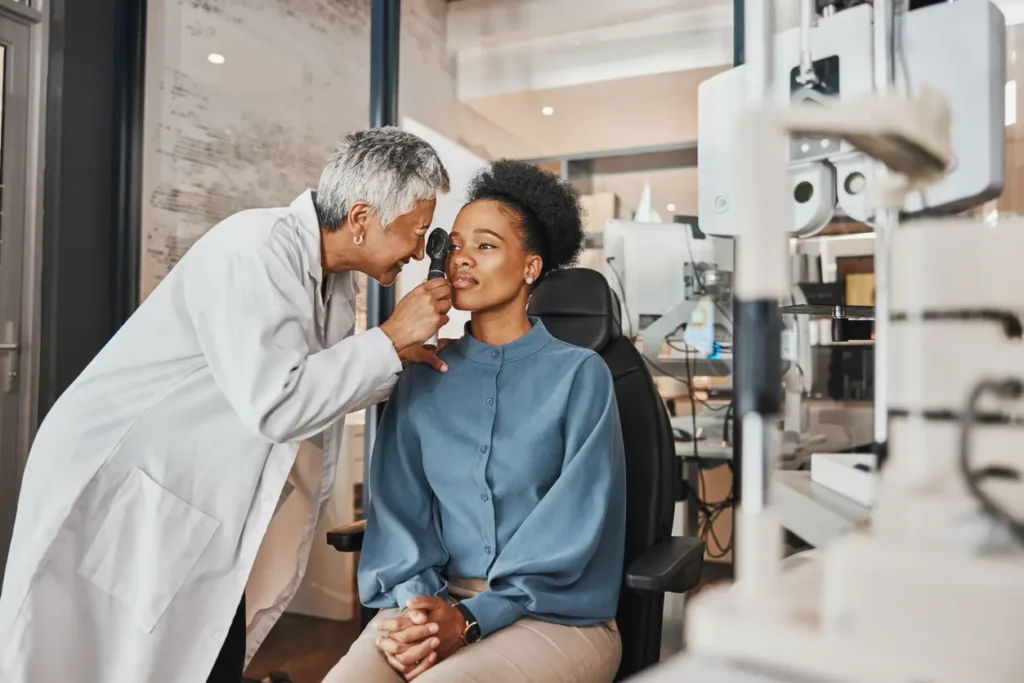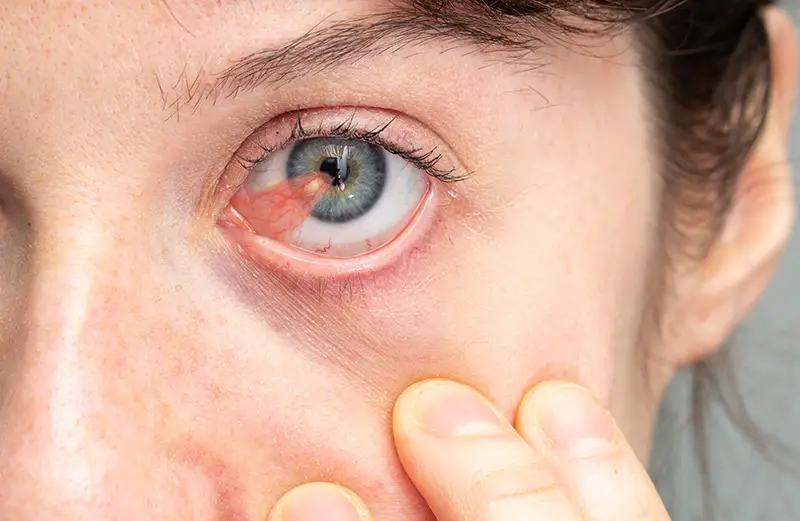Are you noticing a slightly raised, fleshy growth on the white of your eye? It could be pterygium, a condition that not only affects your appearance but can also interfere with your vision.
In this blog, we will explore what pterygium is, explore its common symptoms, and understand what causes it. We’ll also discuss effective treatments and essential self-care tips to manage or potentially prevent its progression. So, let’s get started!
Contents
What is Pterygium?
Pterygium is a common eye condition where a pink, fleshy tissue grows over the white part of the eye, known as the sclera. This growth typically extends from the inner corner near the nose and can slowly move towards the cornea, which is the clear, front surface of the eye.
The appearance of pterygium often resembles a piece of raised, wedge-shaped skin, and it can sometimes become red and irritated. This condition is also sometimes called “surfer’s eye” due to its common occurrence in people frequently exposed to sunlight and wind, such as surfers.
Recognizing the Symptoms of Pterygium
Pterygium can present a range of symptoms that vary from mild to severe as the condition progresses. Here are some common symptoms associated with this eye disease:
- The area near the growth often looks reddish.
- A constant scratchy or gritty feeling, like sand in the eye.
- Feels as if something is stuck in the eye.
- Vision may become blurry.
- Increased tear production.
- Visual disturbance.
- A noticeable raised, white or pink tissue on the white of the eye.
Causes of Pterygium

Pterygium is not caused by a single factor but rather a combination of environmental elements and genetic predisposition. Some of the main causes that contribute to the development of pterygium include:
- Prolonged exposure to ultraviolet (UV) light
- Exposure to wind and dust
- Chronic dry eye conditions
- Genetic predisposition might play a role in the development of pterygium
- Exposure to certain chemicals or irritants
Understanding these causes can help in taking preventive measures, such as wearing protective eyewear and minimizing exposure to harsh environmental conditions, to reduce the risk of developing pterygium.
Managing Pterygium with Self-Care
If you have been diagnosed with pterygium, there are several self-care strategies you can adopt to help manage the symptoms and potentially slow its progression. Here are practical tips to incorporate into your daily routine:
- Wear sunglasses that block both UVA and UVB rays whenever you are outdoors.
- Consider wearing a wide-brimmed hat for additional protection from sunlight.
- Applying artificial tears or lubricating eye drops can help relieve dryness and irritation.
- Avoid rubbing your eyes.
- If possible, reduce exposure to dust, wind, and chemical vapors, especially in work environments.
- If you live in a dry climate, using a humidifier in your home can help maintain moisture in the air.
- Follow up regularly with your eye care professional.
Treatment Options for Pterygium

If you’re dealing with pterygium, there are various treatment options available depending on the severity and progression of the condition. Here’s an overview of the common treatments used to manage or eliminate pterygium:
Mild Cases:
- For mild cases, the above-listed self-care tips could be useful.
Moderate to Severe Cases:
- Surgical Removal: If the pterygium significantly interferes with vision or becomes too uncomfortable, surgical removal may be recommended. The surgery involves removing the growth and placing a graft in its place to prevent recurrence.
- Autografting: This technique involves taking a small piece of the eye’s conjunctiva (the clear lining of the eye) and grafting it to the area where the pterygium was removed. This method is effective at reducing the risk of pterygium coming back.
Advanced Techniques:
- Conjunctival Autografting: This surgical method is considered a gold standard for pterygium removal. It uses tissue from the patient’s own eye to reduce recurrence.
- Amniotic Membrane Transplantation: In more severe cases, an amniotic membrane (a layer from a donated placenta) can be grafted onto the eye to promote healing and reduce inflammation.
After surgery, follow-up care is crucial to monitor healing and prevent the pterygium from returning. This typically involves using prescribed eye drops to reduce inflammation and wearing protective eyewear to shield the eyes from UV exposure.
Pterygium and Pinguecula: Key Differences
| Feature | Pterygium | Pinguecula |
|---|---|---|
| Appearance | Fleshy, wing-shaped growth that extends onto the cornea. | Yellowish, raised bump confined to the conjunctiva. |
| Location | Begins near the inner corner of the eye and can grow across the cornea towards the pupil. | Typically appears on the white part of the eye, either near the nose or on the outer edge. |
| Symptoms | Causes irritation, redness, and a gritty sensation; can distort vision if it covers the cornea. | Mainly causes irritation and dryness; generally does not affect vision. |
| Risk Factors | Linked to UV light exposure, dust, and wind. More likely to grow due to environmental factors. | Also linked to UV light and environmental factors but less likely to grow extensively. |
| Treatment | Lubricating eye drops for mild cases, anti-inflammatory medication, or surgery if it affects vision. | Usually managed with lubricating eye drops and occasionally anti-inflammatory medications; surgery rarely needed. |
Contribute To A Cause!
Protecting our vision is essential for a good quality of life and to prevent diseases that can seriously affect our ability to see. However, many people do not have access to the necessary care to manage or treat eye conditions. This is where your help can make a big difference.
The Eye Mantra Foundation is dedicated to helping those in need, working hard to restore vision for people who cannot afford treatment.
Your Small Donation Can Mean a World of Difference!
Your small donation can bring significant relief to someone’s life. By joining hands with the Eye Mantra Foundation, you give someone the precious gift of sight.
So, click on the Donate Now button to start making a difference.

